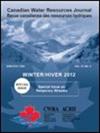Using the ERA5 and ERA5-Land reanalysis datasets for river water temperature modelling in a data-scarce region
IF 1.7
4区 环境科学与生态学
Q3 WATER RESOURCES
引用次数: 5
Abstract
Abstract It has become apparent in recent decades that river water temperature can have immediate and lasting impacts on aquatic organisms and their lotic habitat. In rivers that are dammed, there is an opportunity and a responsibility to regulate flows in order to control these temperatures to ensure the survival of the fish and other aquatic life. This paper uses a physically based hydraulic model (HEC-RAS) to run a water temperature component, allowing the thermal model to simulate water temperatures at the same hourly time step as the hydraulic model in a data-sparse region using two meteorological reanalysis datasets (ERA5 and ERA5-Land) as inputs allowing for a full representation of the diurnal cycle. This was achieved by making use of the HEC-RAS controller to automate the calibration and subsequent simulation processes. Results show that these products are able to provide high-quality thermal simulations on a 200 km river system in British Columbia, Canada, obtaining mean absolute errors in validation of 0.66 °C and a root mean square error of 0.84 °C. Some of the boundary conditions seemed to have little effect on downstream water temperatures. This is due to the measured point of interest being far enough downstream of the dam that a thermal equilibrium is reached well before. Simulations using shorter river reaches confirm that long lakes in the study region contribute to the thermal equilibrium being attained. There also seems to be a limit to the advantage conveyed by increased spatial density of the data, as results indicate a form of skill plateau after a certain input data density is attained.利用ERA5和ERA5- land再分析数据集在数据稀缺地区进行河流水温模拟
摘要近几十年来,河水温度对水生生物及其栖息地产生了直接而持久的影响。在被筑坝的河流中,有机会也有责任调节流量,以控制这些温度,确保鱼类和其他水生生物的生存。本文使用基于物理的水力模型(HEC-RAS)来运行水温组件,允许热模型使用两个气象再分析数据集(ERA5和ERA5-Land)作为输入,在数据稀疏区域模拟与水力模型相同的每小时时间步长的水温,从而完整地表示日周期。这是通过使用HEC-RAS控制器来自动化校准和随后的模拟过程来实现的。结果表明,这些产品能够在200 加拿大不列颠哥伦比亚省km河流系统,在验证中获得0.66的平均绝对误差 °C,均方根误差为0.84 °C。一些边界条件似乎对下游水温影响不大。这是由于测得的兴趣点在大坝下游足够远,很早之前就达到了热平衡。使用较短河段进行的模拟证实,研究区域内的长湖有助于实现热平衡。数据的空间密度增加所带来的优势似乎也受到了限制,因为结果表明,在达到一定的输入数据密度后,会出现一种形式的技能平台。
本文章由计算机程序翻译,如有差异,请以英文原文为准。
求助全文
约1分钟内获得全文
求助全文
来源期刊

Canadian Water Resources Journal
WATER RESOURCES-
CiteScore
2.90
自引率
5.90%
发文量
17
审稿时长
>12 weeks
期刊介绍:
The Canadian Water Resources Journal accepts manuscripts in English or French and publishes abstracts in both official languages. Preference is given to manuscripts focusing on science and policy aspects of Canadian water management. Specifically, manuscripts should stimulate public awareness and understanding of Canada''s water resources, encourage recognition of the high priority of water as a resource, and provide new or increased knowledge on some aspect of Canada''s water.
The Canadian Water Resources Journal was first published in the fall of 1976 and it has grown in stature to be recognized as a quality and important publication in the water resources field.
 求助内容:
求助内容: 应助结果提醒方式:
应助结果提醒方式:


